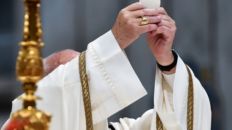Part of the original purpose seems kinda gross to us today
When visiting a Catholic church for Sunday Mass, it is hard not to notice all the parishioners pause for a second as they file in through the various entrances. They stop, dip their fingers in a bowl of water and then make the sign of the cross over their body.
Why do they do that?
Besides remembering Christ’s passion and professing their faith in the Holy Trinity, Catholics bless themselves with holy water primarily as a reminder of our Baptism.
The Catechism of the Catholic Church explains why water plays such an important role in the life of the Church.
“The symbolism of water signifies the Holy Spirit’s action in Baptism, since after the invocation of the Holy Spirit it becomes the efficacious sacramental sign of new birth: just as the gestation of our first birth took place in water, so the water of Baptism truly signifies that our birth into the divine life is given to us in the Holy Spirit. As ‘by one Spirit we were all baptized,’ so we are also ‘made to drink of one Spirit.’ Thus the Spirit is also personally the living water welling up from Christ crucified as its source and welling up in us to eternal life” (CCC 694).
The Catechism further instructs the need for a place within the church walls for a remembrance of this birth in the life of grace.
“The gathering of the People of God begins with Baptism; a church must have a place for the celebration of Baptism (baptistry) and for fostering remembrance of the baptismal promises (holy water font)” (CCC 1185).
Originally the water used for baptisms and holy water fonts was blessed once a year at the Easter Vigil and preserved for the whole year. A portion of the water is still blessed by the priest during a ceremony at the Easter Vigil where the congregation is reminded of the many saving acts of God in history that occurred through the water. The blessing concludes when the Easter candle, representing the Light of Christ, is lowered into the water three times. By this act, the water is deemed “holy” and set apart for this specific function.
Leaving the secular and entering the sacred
In addition to being a reminder of the rebirth experienced at Baptism, holy water fonts also provide a practical function that helps transition from the secular world into the House of God.
According to Fr. John Bartunek at SpiritualDirection.com, the holy water fonts were originally much bigger and were mainly used to cleanse a person’s dirty body before walking into the sacred space.
“Even in ancient non-Christian religions (including Judaism), ritual ablutions (washings) were frequently an initial step in formal worship. And so, when the first Christian houses of worship were built, the atrium that formed a kind of transition space between the outside, public arena and the church proper, where the liturgy was celebrated, often contained a large fountain. Worshipers would stop at the fountain and bathe their hands and feet (shoes were not as common in ancient times as they are now, at least in the warmer climates) before entering the sacred space.”
Even Jesus washed the feet of his disciples before celebrating the first Eucharist.
While not currently used in that same way, holy water fonts still provide a reminder that before we can enter the “Wedding Feast of the Lamb,” we must wash ourselves and put on the “wedding garment” to be admitted to the table.
In the end, while it is sometimes easy to get into the habit of entering a Catholic church and rushing through the ritual of blessing oneself with holy water, the symbolism behind the act is worth pausing a few extra seconds.
It is meant to be a reminder of our Baptism and provides an opportunity to leave behind the secular and enter into the sacred.
PIN THIS

Source: vcatholic.com





